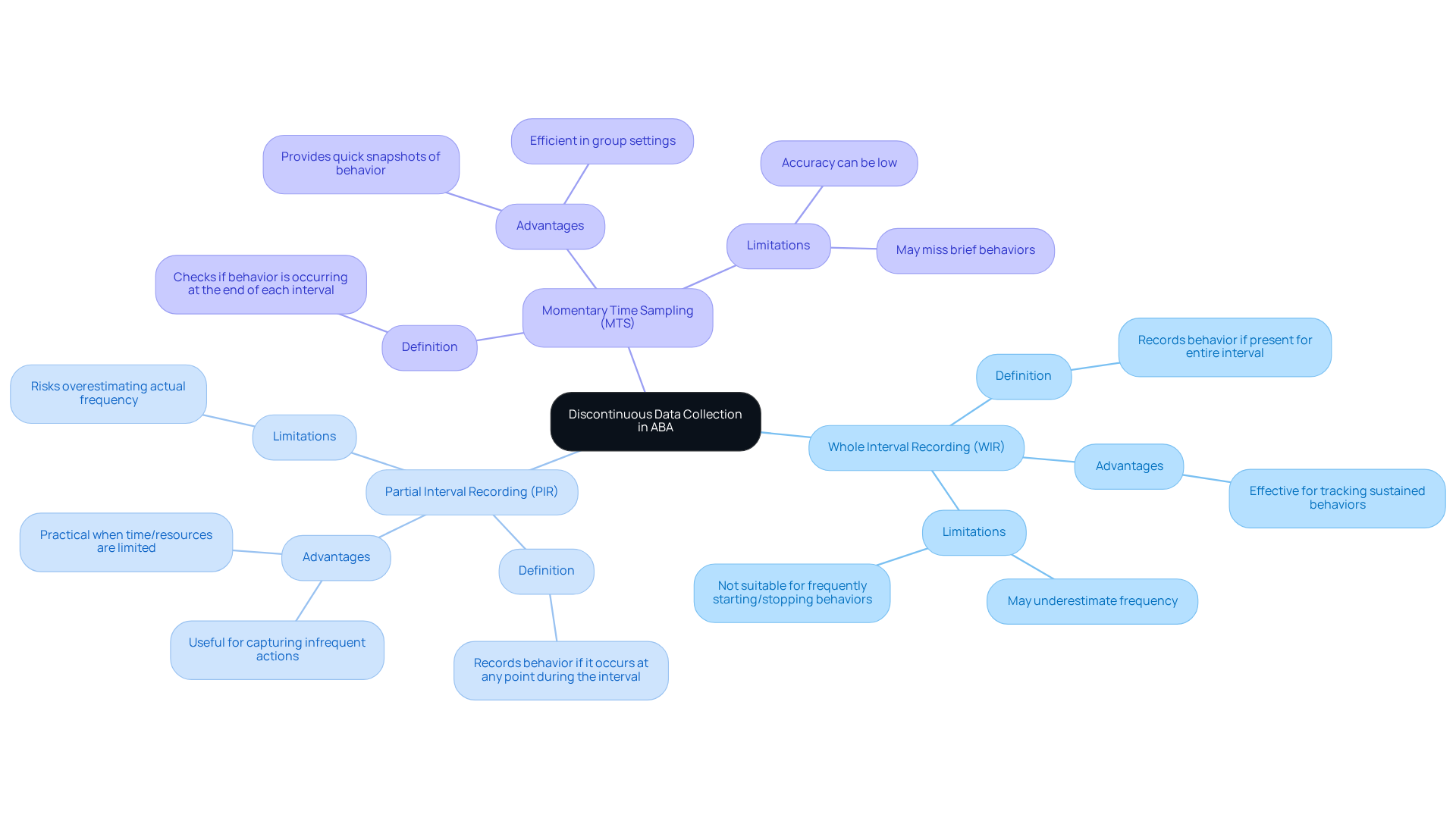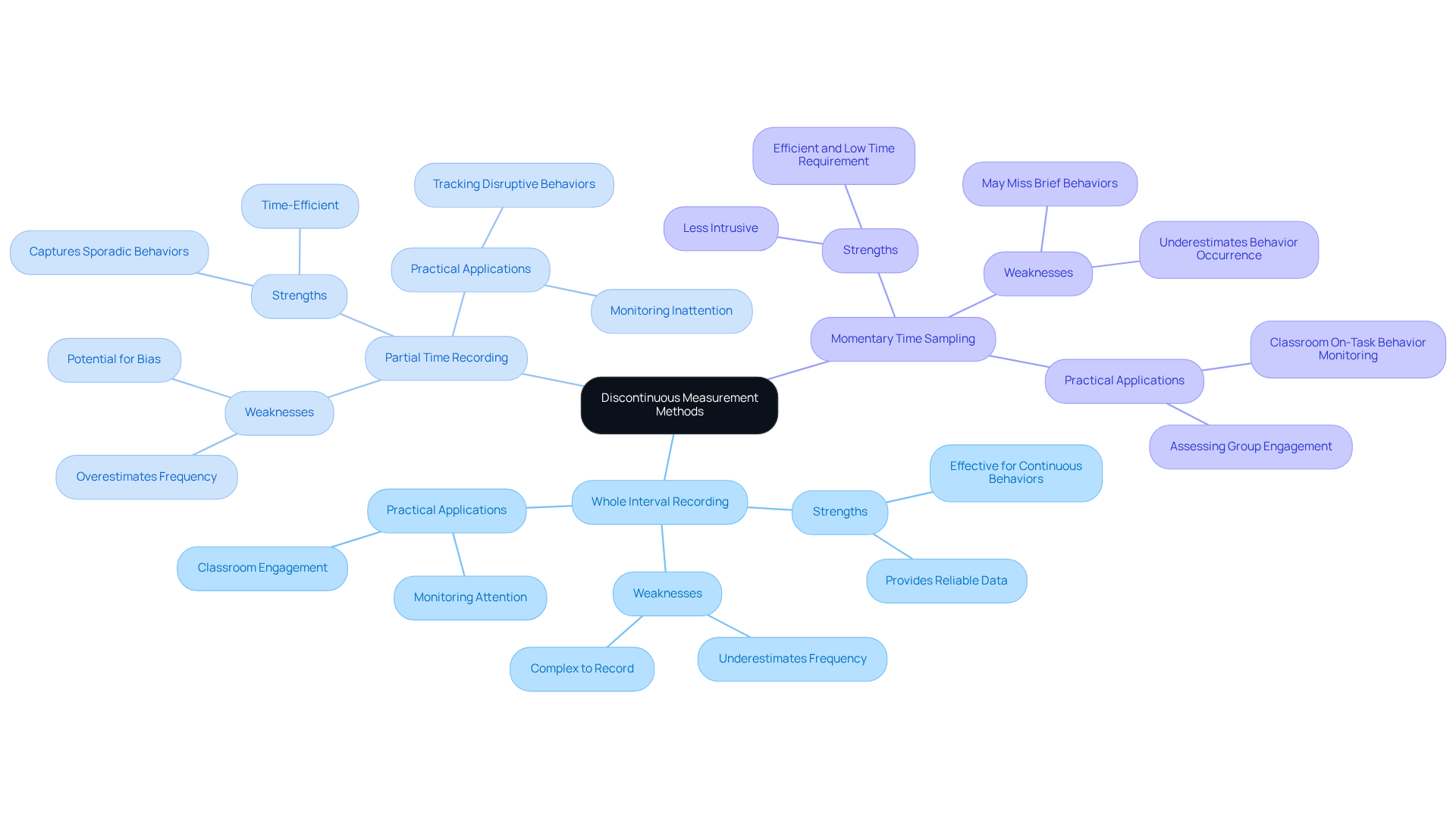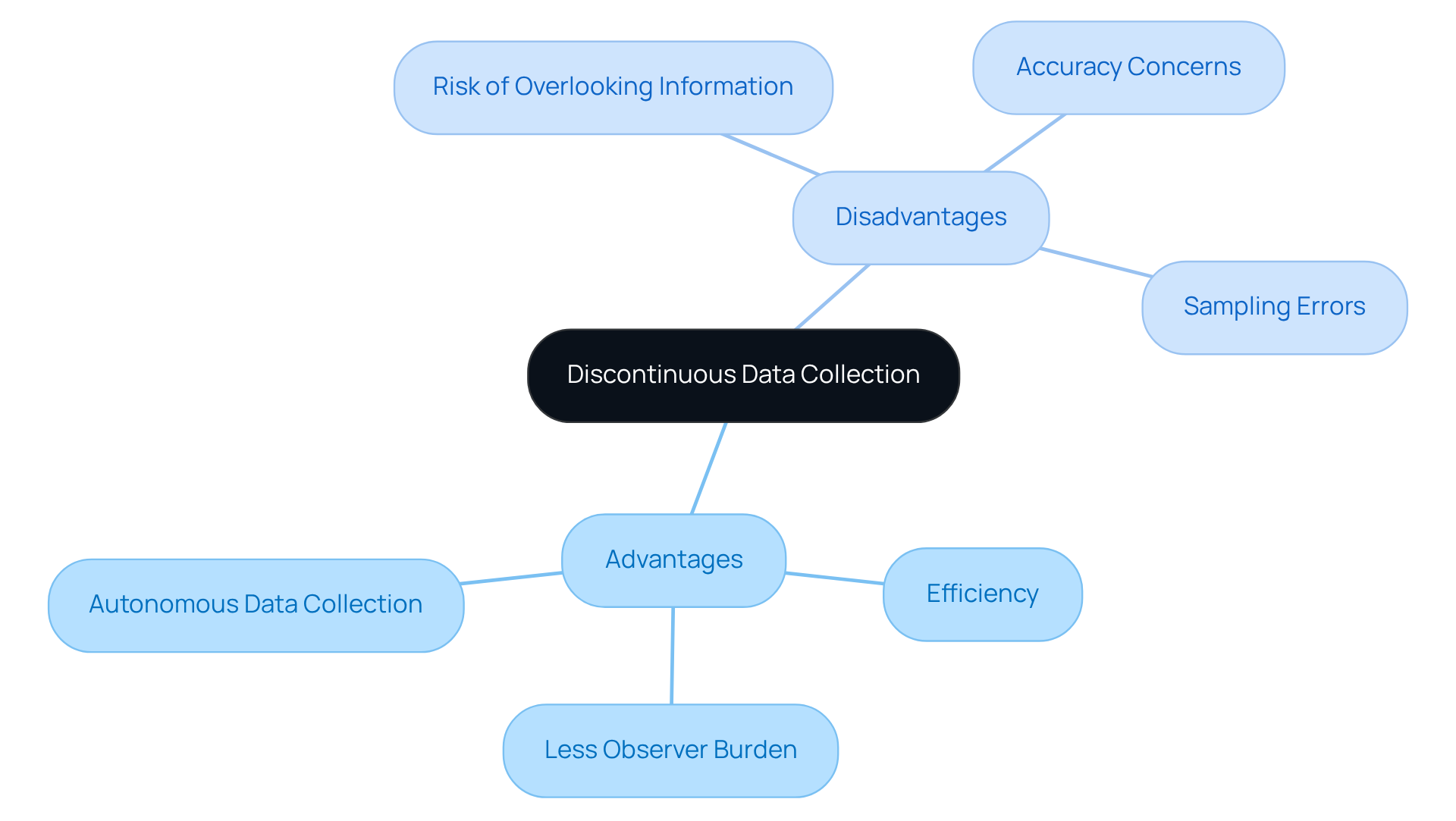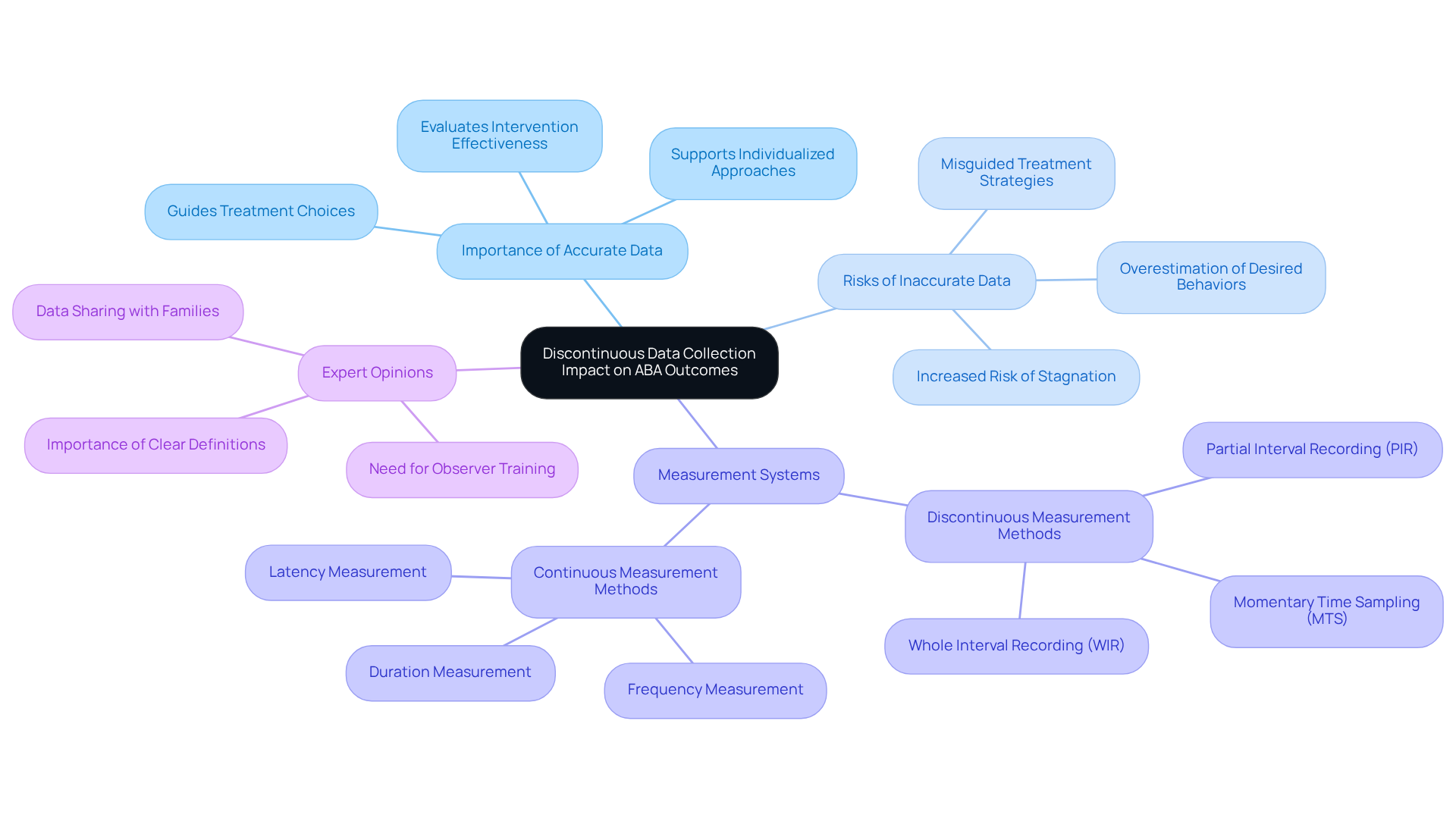September 7, 2025

Discontinuous data collection in Applied Behavior Analysis (ABA) necessitates meticulous implementation, given its potential for both efficiency and inaccuracies in behavior measurement. Techniques such as:
can indeed conserve time and resources. However, they also carry the risk of underestimating or overestimating behaviors. This miscalculation can adversely influence treatment decisions and outcomes if not managed with precision. It is crucial for practitioners to recognize these challenges and address them proactively.
Discontinuous data collection in Applied Behavior Analysis (ABA) presents a compelling intersection of efficiency and complexity. It offers practitioners a streamlined approach to behavior tracking, yet simultaneously poses significant challenges. Techniques such as:
enable professionals to gather critical insights into behavior patterns without the burden of constant observation. However, the potential for inaccuracies—ranging from overestimations to missed opportunities—raises essential questions about the reliability of these methods. How can practitioners effectively balance the need for efficient data collection with the imperative for accurate and comprehensive behavioral analysis?
Discontinuous data collection requires techniques in [Applied Behavior Analysis (ABA)](https://hireaba.today) that involve recording actions at specific intervals rather than through continuous observation. This approach allows practitioners to document whether a behavior occurs during predetermined time frames, streamlining data collection without the need for constant oversight. Discontinuous measurement proves particularly efficient, conserving both time and resources compared to continuous measurement. Common techniques include:
To ensure the reliability of gathered information, it is crucial that observers agree at least 80% of the time, a standard known as . Discontinuous data collection requires valuable roles in therapeutic settings where continuous observation is unfeasible, but it also comes with limitations, such as the potential for underestimating or overestimating the occurrence of behaviors. Furthermore, scatterplots can be utilized to identify trends in a learner's actions over time, enhancing the analysis of collected data.
By carefully selecting the appropriate technique based on the behavior being assessed and the specific objectives of the evaluation, practitioners can effectively monitor behavior patterns and make informed decisions to improve therapeutic outcomes. As April Torres, M.Ed., BCBA, aptly stated, 'Discontinuous data collection requires less total time investment, but it can be even trickier to track.

Discontinuous measurement methods in Applied Behavior Analysis (ABA) encompass several key techniques that are essential for effective practice.
Each of these techniques serves distinct purposes in data collection. For practical application, utilizing 1-minute intervals for tracking during a 20-minute session is recommended. In ABA therapy, accurate data collection and effective intervention planning are crucial, and discontinuous data collection requires a clear understanding of the strengths and limitations of these techniques. Additionally, practitioners must recognize that discontinuous data collection requires an awareness of measurement error trends associated with these methods, as they can influence data accuracy and treatment decisions.

In Applied Behavior Analysis (ABA) environments, discontinuous data collection requires techniques that present significant advantages, making them appealing. Their effectiveness stands out as a primary benefit; these approaches are particularly suitable for fast-paced settings because discontinuous data collection requires considerably less time and resources compared to continuous information gathering. Additionally, they alleviate the observer burden, allowing practitioners to collect data without the necessity of monitoring every instance of behavior, thus fostering a more autonomous information collection process.
Nevertheless, the challenges that accompany the implementation of methods indicate that discontinuous data collection requires notable attention. A critical disadvantage is the risk of overlooking vital information. Since these techniques capture behaviors only at specific intervals, important events occurring outside these observation phases may be missed, leading to incomplete data. Moreover, accuracy concerns arise with discontinuous measurement. These methods can result in both overestimation and underestimation of activity frequency and duration, which can profoundly affect treatment decisions and outcomes. For example, reliance on Partial Interval Recording (PIR) may inflate perceptions of behaviors, as actions could be recorded as occurring even if they transpired only briefly during the interval. Similarly, Momentary Time Sampling (MTS) may underestimate behavior due to its inherent sampling nature.
Practitioners must also remain vigilant regarding potential sampling errors and estimation biases when employing discontinuous measurement techniques. Understanding these factors is crucial for , as discontinuous data collection requires it in ABA. Best practices, including the clear definition of intervals and the establishment of operational definitions, should be prioritized to enhance the reliability of the data collected. Ultimately, practitioners need to thoughtfully weigh the implications of using discontinuous methods, striving to strike a balance between efficiency and the necessity for accurate and comprehensive behavior analysis.

Discontinuous data collection requires a profound effect on ABA outcomes. Precise information gathering serves as the foundation for effective ABA therapy, guiding treatment choices and evaluating intervention effectiveness. When applied properly, can provide valuable insights into conduct patterns, allowing practitioners to customize interventions accordingly.
However, discontinuous data collection requires attention, as inaccuracies or incomplete data can lead to misguided treatment strategies, adversely affecting patient progress. For instance, research has shown that partial interval recording often results in an overestimation of a child's engagement in desired behaviors, potentially leading to less effective interventions. This highlights that optimal outcomes in ABA therapy necessitate careful implementation and thoughtful selection of measurement methods, as discontinuous data collection requires.
Moreover, research suggests that the selection of measurement systems greatly affects treatment choices, emphasizing the necessity of employing trustworthy and valid information gathering methods. Expert opinions highlight that without rigorous data collection practices, the risk of stagnation in therapy increases, ultimately compromising the potential for meaningful behavioral improvements.

Discontinuous data collection in Applied Behavior Analysis (ABA) serves as a pivotal approach for practitioners aiming to enhance their data-gathering efficiency while managing limited observation resources. By employing techniques such as:
clinicians can effectively capture essential behavior patterns without the necessity of constant monitoring. This not only streamlines the analysis process but also enhances the effectiveness of client behavior assessment.
The article delineates the strengths and weaknesses inherent in these discontinuous measurement methods, underscoring the critical importance of selecting the appropriate technique based on the behavior being assessed and the objectives of the evaluation. While discontinuous data collection can significantly minimize time and effort, it is essential to acknowledge the potential for inaccuracies, including the risk of overestimating or underestimating behavior occurrences. Recognizing these limitations is paramount for practitioners to ensure that their data collection methods underpin accurate treatment planning and effective interventions.
Ultimately, the meticulous implementation of discontinuous data collection techniques in ABA is vital for achieving meaningful therapeutic outcomes. Practitioners are urged to remain vigilant regarding the potential challenges and biases associated with these methods while prioritizing best practices to enhance data reliability. By cultivating a comprehensive understanding of these techniques, professionals can markedly improve their ability to track behavior changes and adapt interventions effectively, ultimately leading to superior support for individuals in therapeutic settings.
What is discontinuous data collection in Applied Behavior Analysis (ABA)?
Discontinuous data collection in ABA involves recording behaviors at specific intervals instead of through continuous observation. This method allows practitioners to document whether a behavior occurs during predetermined time frames, making data collection more efficient.
What are the common techniques used in discontinuous data collection?
Common techniques include: - Whole Interval Recording (WIR): Records a behavior as occurring only if it is present for the entire interval. - Partial Interval Recording (PIR): Notes an action if it occurs at any point during the interval. - Momentary Time Sampling (MTS): Checks if a behavior is occurring at the end of each interval.
What is the advantage of using discontinuous measurement?
Discontinuous measurement is efficient as it conserves time and resources compared to continuous measurement, allowing for effective data collection without the need for constant oversight.
What is inter-observer agreement (IOA) and why is it important?
Inter-observer agreement (IOA) is the standard that observers must agree at least 80% of the time on the recorded behaviors. It is crucial for ensuring the reliability of the data gathered through discontinuous data collection.
What are the limitations of discontinuous data collection?
Limitations include the potential for underestimating or overestimating the occurrence of behaviors, which can affect the accuracy of the data collected.
How can scatterplots be utilized in discontinuous data collection?
Scatterplots can be used to identify trends in a learner's actions over time, enhancing the analysis of the collected data.
How should practitioners choose a technique for discontinuous data collection?
Practitioners should carefully select the appropriate technique based on the behavior being assessed and the specific objectives of the evaluation to effectively monitor behavior patterns and improve therapeutic outcomes.
Our expert recruitment strategies and AI-driven sourcing ensure that you receive top-notch candidates quickly, without compromising on quality. Whether you’re looking for BCBAs, Clinical Directors, or RBTs, we’ve got you covered.